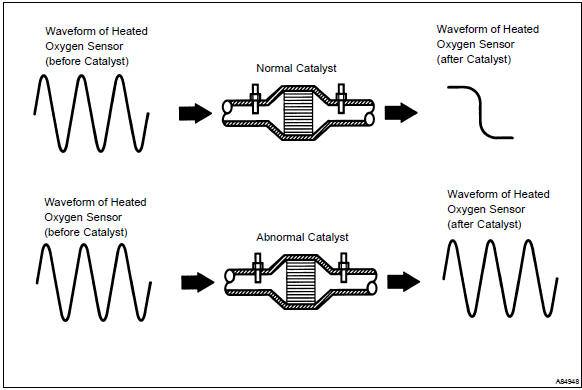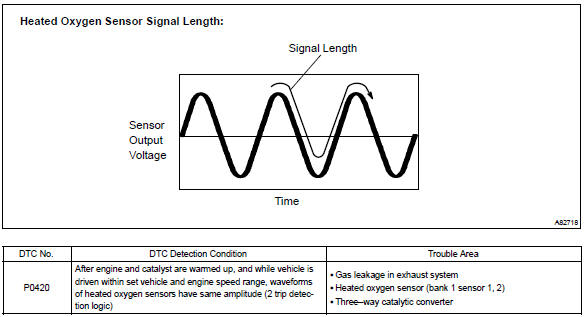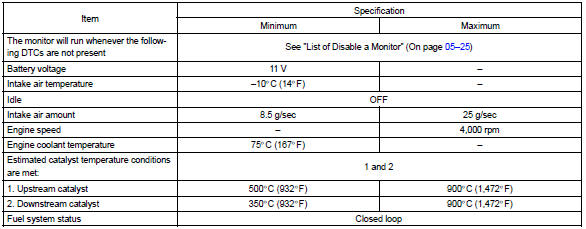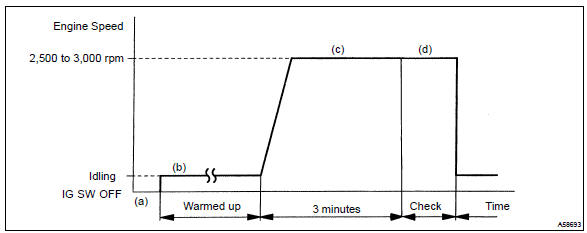Toyota Corolla (E120) 2002–2008 Repair Manual / Diagnostics / Sfi system / Catalyst system efficiency below
threshold / Circuit description
Toyota Corolla (E120): Circuit description
The ecm compares the two waveforms of the heated oxygen sensors located before and after the catalyst to determine whether or not the catalyst performance has deteriorated.
Air–fuel ratio feedback compensation keeps the waveform of the heated oxygen sensor in front of the catalyst alternates between back and forth, from rich to lean.
If the catalyst is functioning normally, the waveform of the heated oxygen sensor behind the catalyst switches back and forth between rich and lean much more slowly than the waveform of the heated oxygen sensor in front of the catalyst.
When both waveforms change at a similar rate, it indicates that the catalyst performance has deteriorated.
Monitor description
The vehicle is equipped with the two oxygen sensors (o2s). One is mounted upstream from the three–way catalytic (twc) converter (front heated oxygen sensor ”sensor 1” ), the second is mounted downstream (heated oxygen sensor ”sensor 2” ). The catalyst efficiency monitor compares the sensor 1 and 2 signals in order to calculate twc ability to store oxygen.
During normal operation, the twc stores and releases oxygen as needed. This results in low oxygen variations in the post twc exhaust stream as shown.

As the twc’s efficiency degrades, its ability to store oxygen is reduced. This causes higher variations in post twc exhaust stream oxygen content and results in increased sensor 2 signal activity as shown.
When running the monitor, the ecm compares sensor1 and sensor 2 signals over a specific time to determine the twc efficiency. The ecm begins by calculating the signal length for both sensors.

Monitor strategy

Typical enabling conditions

Typical malfunction thresholds

Component operating range

Monitor result (mode 06 data)

Refer for detailed information on checking monitor status.
Confirmation driving pattern

- Connect the hand–held tester to the dlc3, or connect the probe of the oscilloscope between terminals ox1a, ox1b and e1 of the ecm connector.
- start the engine and warm it up with all the accessories switched off until the engine coolant temperature becomes stable.
- run the engine at 2,500 to 3,000 rpm for about 3 minutes.
- after confirming that the waveform of the bank 1 sensor 1 (ox) which oscillates between 0 v and 1 v under a feedback to the ecm, check the waveform of the bank 1 sensor 2 (ox).
Hint
: if there is malfunction in the system, the waveform of ”sensor 2” (oxl2) may become a similar to the one of ”sensor1” (oxl1) shown in the diagram on the left.

Other materials:
Using the interior lights
Interior lights list
1 Front interior light/personal lights
2 Rear interior light
3 Engine switch light (vehicles with a smart key system)
Front interior light/personal lights
■ Front interior light
► Type A
► Type B
1 Off
2 Door position
3 On
■ Personal li ...
Basic Audio Operations
Basic audio operations and functions common to each mode are explained in
this section.
Operating the multimedia system
Random playback
Select to change on/off.
Repeat play
Select to change on/off.
■Using cellular phones
Interference may be heard through the multimedia system' ...
Using a top tether anchorage
(for Puerto Rico)
■ Top tether anchorages
Top tether anchorages are provided
for each rear seat.
Use top tether anchorages
when fixing the top strap.
Top tether anchorages
Top strap
■ Fixing the top strap to the
top tether anchorages
Install the child restraint system
in accordance to the operation
manual e ...


